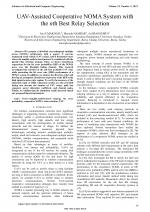| 3/2023 - 5 |
UAV-Assisted Cooperative NOMA System with the nth Best Relay SelectionUMAKOGLU, I. |
| Extra paper information in |
| Click to see author's profile in |
| Download PDF |
Author keywords
amplify-and-forward relaying, bit error probability, cooperative NOMA, relay selection, UAV
References keywords
noma(18), comm(16), access(14), relay(13), cooperative(11), selection(10), performance(10), analysis(9), systems(7), networks(7)
Blue keywords are present in both the references section and the paper title.
About this article
Date of Publication: 2023-08-31
Volume 23, Issue 3, Year 2023, On page(s): 39 - 46
ISSN: 1582-7445, e-ISSN: 1844-7600
Digital Object Identifier: 10.4316/AECE.2023.03005
Web of Science Accession Number: 001062641900005
SCOPUS ID: 85172311920
Abstract
We propose a downlink non-orthogonal multiple access (NOMA) architecture with a source, N one-way unmanned aerial vehicle (UAV) relays, and K destination users where the amplify-and-forward protocol is considered with the partial relay selection strategy. Then, we derive closed-form expressions for the bit error probability (BEP) of the NOMA users over the Rayleigh fading channel. This research investigated the selection of the nth best available UAV relay while presenting the bit error rate (BER) performance of a NOMA system. In addition, we analyze the diversity order and develop an asymptotic closed-form expression of the BEP in the high signal-to-noise ratio regime. To verify the accuracy of the analytical study of BER, numerical results are also provided taking into account the number of UAV relays, path loss exponent, power allocation coefficient, and channel gains. Finally, we validate that the simulation results precisely match our proposed theoretical analysis. |
| References | | | Cited By |
Web of Science® Times Cited: 4 [View]
View record in Web of Science® [View]
View Related Records® [View]
Updated today
SCOPUS® Times Cited: 7
View record in SCOPUS® [Free preview]
View citations in SCOPUS® [Free preview]
[1] Deep Learning-Assisted Signal Detection for OTFS-NOMA Systems, Umakoglu, Inci, Namdar, Mustafa, Basgumus, Arif, IEEE Access, ISSN 2169-3536, Issue , 2024.
Digital Object Identifier: 10.1109/ACCESS.2024.3449812 [CrossRef]
[2] Microstrip Patch Antenna Design for 5G and Beyond Wireless Communication Systems, Barışer, Bahar, Umakoğlu, İnci, Namdar, Mustafa, Başgümüş, Arif, Journal of Scientific Reports-A, ISSN 2687-6167, Volume , 2024.
Digital Object Identifier: 10.59313/jsr-a.1518956 [CrossRef]
[3] Performance Analysis of NOMA-V2V Cooperative Systems with Outdated CSI and Imperfect SIC, Liang, Xiaolin, Shi, Xujing, Cao, Wangbin, Liu, Shuaiqi, Xu, Jianpeng, Zhao, Xiongwen, Wireless Personal Communications, ISSN 0929-6212, Issue 4, Volume 134, 2024.
Digital Object Identifier: 10.1007/s11277-024-11005-6 [CrossRef]
[4] Clustering Approach for Reliable Wireless Communication, Florea, Carmen, Berceanu, Mădălina-Georgiana, Trifan, Răzvan-Florentin, Marcu, Ioana-Manuela, Applied Sciences, ISSN 2076-3417, Issue 1, Volume 14, 2023.
Digital Object Identifier: 10.3390/app14010013 [CrossRef]
[5] Secrecy outage probability and strictly positive secrecy capacity of UAV assisted cooperative NOMA system with two untrusted destinations, Khan, Mohd Javed, Ahmad, Saif, Singh, Indrasen, Sahu, Umesh Kumar, Scientific Reports, ISSN 2045-2322, Issue 1, Volume 15, 2025.
Digital Object Identifier: 10.1038/s41598-025-92321-0 [CrossRef]
[6] Outage Analysis of IRS-NOMA System over η - μ Fading Channel, Srinivasarao, K., Rao, V. Venkata, Sharma, Priyank, International Journal of Sensors, Wireless Communications and Control, ISSN 2210-3279, Issue 1, Volume 15, 2024.
Digital Object Identifier: 10.2174/0122103279312349240710060042 [CrossRef]
[7] Performance Evaluation of OTFS-NOMA Scheme for High Mobility Users, UMAKOĞLU, İnci, NAMDAR, Mustafa, BAŞGÜMÜŞ, Arif, Sakarya University Journal of Computer and Information Sciences, ISSN 2636-8129, Issue 3, Volume 6, 2023.
Digital Object Identifier: 10.35377/saucis...1391813 [CrossRef]
Disclaimer: All information displayed above was retrieved by using remote connections to respective databases. For the best user experience, we update all data by using background processes, and use caches in order to reduce the load on the servers we retrieve the information from. As we have no control on the availability of the database servers and sometimes the Internet connectivity may be affected, we do not guarantee the information is correct or complete. For the most accurate data, please always consult the database sites directly. Some external links require authentication or an institutional subscription.
Web of Science® is a registered trademark of Clarivate Analytics, Scopus® is a registered trademark of Elsevier B.V., other product names, company names, brand names, trademarks and logos are the property of their respective owners.
Faculty of Electrical Engineering and Computer Science
Stefan cel Mare University of Suceava, Romania
All rights reserved: Advances in Electrical and Computer Engineering is a registered trademark of the Stefan cel Mare University of Suceava. No part of this publication may be reproduced, stored in a retrieval system, photocopied, recorded or archived, without the written permission from the Editor. When authors submit their papers for publication, they agree that the copyright for their article be transferred to the Faculty of Electrical Engineering and Computer Science, Stefan cel Mare University of Suceava, Romania, if and only if the articles are accepted for publication. The copyright covers the exclusive rights to reproduce and distribute the article, including reprints and translations.
Permission for other use: The copyright owner's consent does not extend to copying for general distribution, for promotion, for creating new works, or for resale. Specific written permission must be obtained from the Editor for such copying. Direct linking to files hosted on this website is strictly prohibited.
Disclaimer: Whilst every effort is made by the publishers and editorial board to see that no inaccurate or misleading data, opinions or statements appear in this journal, they wish to make it clear that all information and opinions formulated in the articles, as well as linguistic accuracy, are the sole responsibility of the author.



